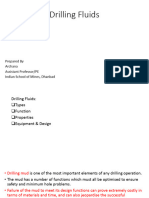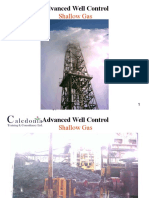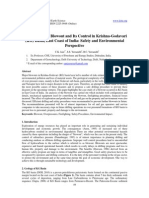Fundamentals of Drilling (Density (Mud Weight) Test)
Fundamentals of Drilling (Density (Mud Weight) Test)
Uploaded by
Ahmed ShahoyiCopyright:
Available Formats
Fundamentals of Drilling (Density (Mud Weight) Test)
Fundamentals of Drilling (Density (Mud Weight) Test)
Uploaded by
Ahmed ShahoyiOriginal Title
Copyright
Available Formats
Share this document
Did you find this document useful?
Is this content inappropriate?
Copyright:
Available Formats
Fundamentals of Drilling (Density (Mud Weight) Test)
Fundamentals of Drilling (Density (Mud Weight) Test)
Uploaded by
Ahmed ShahoyiCopyright:
Available Formats
Fundamentals of Drilling
Density (Mud Weight) Test
Supervisor : Dr. Sarkar
Prepared By : Ahmed Saadi Avdal
Teaching Asistant : Mr. Hamid
Fundamentals of Drilling Density ( Mud Weight ) Test 1
Contents
Density (Mud Weight) Test
• Aim of Experiment
• Theory
• Apparatus
• Calibration
• Procedure
• Discussion
• Conclusion
Fundamentals of Drilling Density ( Mud Weight ) Test 2
Aim of Experiment
The main objectives of density (mud weight) tests in drilling operation are to maintain
borehole stability, control well pressure, and improve drilling efficiency, while maintaining the
drilling fluid density. Here are the specific objectives:
1. Prevent Blowouts :
To prevent blowouts, the drilling fluid creates a hydrostatic pressure greater than the
formation pressure by maintaining a mud weight greater than the formation pressure, to
keep formation fluids from flowing into the wellbore.
2. Control Wellbore Pressure :
The drilling fluid density helps balance the forming of the pressure. The denser mud is
used to counteract the formation pressure and prevent kicks if that pressure is higher
than anticipated. On the other hand, if the formation pressure is lower, the risk of
collapse of the wellbore is reduced by using a shallower mud.
3. Ensure Borehole Stability :
A good mud weight can support and prevent collapsing of the well bore walls. It is
particularly important for weak or unstable formations.
4. Optimize Drilling Efficiency :
Maintaining the optimal mud weight allows optimization of drilling rate and ensures a
minimum drilling cost. Too heavy mud can cause borehole instability and slow drilling
unless the mud is too light which won't provide enough support. Then if the mud is too
heavy, it can add to the torque that the drill imposes on the bit and the drilling bit itself.
5. Monitor Formation Properties :
Geologists can discover information about the formation properties, porosity,
permeability from mud weight required to maintain borehole stability analysis.
6. Prevent Wellbore Casing Collapse :
The factor which helps to prevent the collapse of casing in cased wellbores is mud
weight.
density (mud weight) tests provide assurance that safe and efficient drilling operations can be
carried out in the presence of pressures and controlling them, and at the same time optimized
drilling efficiency can be achieved.
Fundamentals of Drilling Density ( Mud Weight ) Test 3
Theory
The theory of density, particularly in the context of mud weight, is crucial in drilling
operations. Density refers to the mass per unit volume of a substance, and it is typically
expressed in units such as grams per cubic centimeter (g/cm³) or pounds per gallon (ppg).
In drilling, mud weight is the density of the drilling fluid used to stabilize the wellbore. It is
essential for balancing the pressure exerted by the surrounding rock formations and preventing
blowouts. The mud weight must be carefully calculated based on the depth of the well and the
geological conditions encountered.
The formula to calculate the mud weight is:
𝐷𝑒𝑝𝑡ℎ (𝑓𝑡) × 𝐹𝑜𝑟𝑚𝑎𝑡𝑖𝑜𝑛 𝑃𝑟𝑒𝑠𝑠𝑢𝑟𝑒 𝐺𝑟𝑎𝑑𝑖𝑒𝑛𝑡 (𝑝𝑠𝑖/𝑓𝑡)
𝑀𝑢𝑑 𝑊𝑒𝑖𝑔ℎ𝑡 (𝑝𝑝𝑔) =
0.052
Where:
• Depth is the vertical depth of the wellbore in feet.
• Formation Pressure Gradient is the pressure exerted by the formation fluid, typically
around 0.433 psi per foot of depth for freshwater.
By adjusting the density of the drilling mud, operators can control the pressure in the wellbore,
ensuring safe and efficient drilling operations.
understanding the theory of density and mud weight is essential for effective drilling practices
and maintaining well control.
Shortly Mud weight is the density of the drilling fluid used to stabilize the wellbore.
Fundamentals of Drilling Density ( Mud Weight ) Test 4
Apparatus
• Hydrometer
• Sample Cup
• Scale
• Graduated Cylinder
• Mud Balance
Fundamentals of Drilling Density ( Mud Weight ) Test 5
Calibration
• Set the cup aside, remove the lid, fill the cup with water to the top, and put the lid back
on it.
• Replace the lid and wipe dry.
• Instead, replace the balance arm on the base with a knife edge which rests on the
fulcrum.
• When set to 8.33, the rider should be centered on the level vial. Unless, then, you add
to or remove shot from the well in the bream, end of.
Procedure
I. Take the cup and remove the lid, then fill the cup with mud to be tested, all the way to
the top.
II. Replace the lid, and rotate until it is firmly seated, and some mud is pushed up through
the hole in the cup.
III. The outside mud is wiped or washed from the cup.
IV. Set the balance arm onto the base while putting the rest of the knife edge on the fulcrum.
V. You then move the rider until the graduated arm is level by the level vial on the beam.
VI. Reading the density at the left hand edge of the rider, without disturbing the rider, in all
desired units, from the edge of the rider to the edge of the lever.
VII. Record mud temperature versus density.
Fundamentals of Drilling Density ( Mud Weight ) Test 6
Discussion
A very important action from the drilling point of view is the density or mud weight test (the
density or mud weight test) which is used in the oil and gas drilling. The drilling mud density
test measures the density of the drilling mud, a fluid that helps cool and oil the drill bit on the
bottom of the hole, carries up the rock cuttings, and helps force any unwanted fluids from the
hole. Here are the important factors of a density test:
• Purpose :
To make sure that the mud weight is suitable to the formation conditions that we are
experiencing, we perform a density test. In addition, several reasons why it’s important
include firstly to prevent wellbore unplanned, than to debug formation pressure and
finally, to prevent release.
• Measurement :
It is measured mostly in weight of the liquid per gallon in pounds per gallon (ppg) or in
mass per cubic centimeter (g/cm3). A mud balance is an instrument used for exact mud
density determination, and this test can be done.
• Procedure :
➢ The mud system shall sample the drilling mud.
➢ Sample is kept in cup of mud balance and balance made level.
➢ Density is computed from sample volume, and the sample weight is recorded.
• Interpretation :
The purpose of the density tests is to analyze if the present mud weight is suitable for
drilling operation, as unnecessary well control problems can be induced by low density
and by high density the formation is excessively pressured with potential formation
damage.
• Adjustments :
Depending on the results, add weighting agents (e.g., barite) or water to mud
formulation to make mud the desired density.
Fundamentals of Drilling Density ( Mud Weight ) Test 7
Conclusion
Drilling operations depend on the density (mud weight) test and they directly determine safety
and efficiency of those operations. Drilling fluid mass per unit volume is defined as mud
weight expressed in pounds per gallon (ppg) or kilograms per liter (kg/L). This measurement
enables the ability to maintain hydrostatic pressure to offset formation pressure. Excess mud
weight may cause fracturing of the formation, while too few mud pounds put you in dangerous
situations like blowouts. It is used to check wellbore stability by making adjustments in fluid
properties such as weighting agents or changing viscosity.
Drilling conditions can change rapidly, and it is therefore important to continuously monitoring
mud weight. Regular density tests are used to provide the benchmarks, against which the
drilling fluid must perform under the various pressures and temperatures. The dynamics that
it allows the drilling team to deal with, can alter how much mud weight is picked up in the
weighting section. In the end, the density test plays a central role in the management of the
drilling fluid, maintains wellbore stability, controls formation pressures, as well as the safety
and efficiency of operations. Managing mud weight properly reduces risks and improves
drilling success.
Fundamentals of Drilling Density ( Mud Weight ) Test 8
You might also like
- SFI GroupTableDocument8 pagesSFI GroupTableAmitabha100% (2)
- Test ProcedureDocument27 pagesTest ProcedureAjayNo ratings yet
- Deepwater Horizon Accident Investigation Report Appendices ABFGHDocument37 pagesDeepwater Horizon Accident Investigation Report Appendices ABFGHBren-RNo ratings yet
- Mud Density Lab Report 1Document11 pagesMud Density Lab Report 1kurddoski2880% (5)
- Density Test Using Mud BalanceDocument14 pagesDensity Test Using Mud BalanceRatha MenNo ratings yet
- Full Lab 1Document18 pagesFull Lab 1Zafirah ZaidiNo ratings yet
- PNG 451 Lab Manual 2012Document96 pagesPNG 451 Lab Manual 2012Alex RobertNo ratings yet
- Checked byDocument14 pagesChecked byMark KaiserNo ratings yet
- Al Ayen University College of Engineering Petroleum DepartmentDocument5 pagesAl Ayen University College of Engineering Petroleum DepartmentMohammedalwaelyNo ratings yet
- Drilling: University of Zakho College of Engineering Mechanical DepartmentDocument17 pagesDrilling: University of Zakho College of Engineering Mechanical DepartmentAbdullwahid AhmedNo ratings yet
- Drilling Fluid 2 (C5)Document44 pagesDrilling Fluid 2 (C5)jibriilmustafa5100% (1)
- Unit 2Document54 pagesUnit 2gaurav sukhariaNo ratings yet
- معمل سوائل حفر أ.حامدDocument56 pagesمعمل سوائل حفر أ.حامدHaZard ZaYedNo ratings yet
- Drilling Fluid IntroductionDocument16 pagesDrilling Fluid IntroductionHomam MohammadNo ratings yet
- Ararat Private Technical InstituteDocument14 pagesArarat Private Technical InstituteKhairy Omer100% (1)
- Lab Manual Foundation EngineeringDocument39 pagesLab Manual Foundation Engineeringartiraha100% (1)
- Mud WeightDocument9 pagesMud Weightسجاد كريم هاشم سماويNo ratings yet
- Lab Report Exp 1Document9 pagesLab Report Exp 1hari6622No ratings yet
- Drilling Fluid TechDocument77 pagesDrilling Fluid TechAllbert EinsteinNo ratings yet
- Expt 3Document12 pagesExpt 3JV RatmanNo ratings yet
- Mud DensityDocument7 pagesMud Densityhindn162No ratings yet
- Lab Manual 6 and 7Document8 pagesLab Manual 6 and 7Prabesh PokharelNo ratings yet
- Drilling Engineering Lab2Document15 pagesDrilling Engineering Lab2yosifNo ratings yet
- Research Designs & Standards Organisation (R.D.S.O.) : Summer Training ReportDocument76 pagesResearch Designs & Standards Organisation (R.D.S.O.) : Summer Training ReportPraveen SrivastavaNo ratings yet
- Experiment No.15 Consolidation TestDocument9 pagesExperiment No.15 Consolidation TestKhushalchand BhandariNo ratings yet
- Consolidation Test: Need and ScopeDocument6 pagesConsolidation Test: Need and ScopeSwapan PaulNo ratings yet
- Lab Manual Foundation EnggDocument39 pagesLab Manual Foundation EnggsahilkaushikNo ratings yet
- Candelaria Experiment3 SoilMechLabDocument12 pagesCandelaria Experiment3 SoilMechLabHarley O. CandelariaNo ratings yet
- Cement Slurry Density TestDocument14 pagesCement Slurry Density TestAli NasirNo ratings yet
- Consolidation (Part 2) Lecture 2Document36 pagesConsolidation (Part 2) Lecture 2Jawad AhmadNo ratings yet
- Lab 1 Cge558Document17 pagesLab 1 Cge558Harith NordinNo ratings yet
- Method Statement For Consolidation Grouting in RockDocument7 pagesMethod Statement For Consolidation Grouting in RockK ParthNo ratings yet
- Drillingfluids (L15)Document78 pagesDrillingfluids (L15)Erison KaramaniNo ratings yet
- Dilution: 3 ExperimentDocument10 pagesDilution: 3 ExperimenthamaNo ratings yet
- Mud Densities Exp NewDocument8 pagesMud Densities Exp NewHafizszul FeyzulNo ratings yet
- 1 SiteinvestigationDocument51 pages1 SiteinvestigationSelah AbdulahiNo ratings yet
- Drilling FluidDocument42 pagesDrilling Fluidkiran100% (1)
- Relative DensityDocument14 pagesRelative DensitygatotNo ratings yet
- Open Ended Lab For Soil MechanicsDocument27 pagesOpen Ended Lab For Soil Mechanicsعثمان محيب احمدNo ratings yet
- Drilling FluidsDocument15 pagesDrilling FluidsMaclean Jacob Eneotu100% (1)
- Geotechnical Engineering 2 1Document325 pagesGeotechnical Engineering 2 1Arpan NandyNo ratings yet
- GEOTECHDocument16 pagesGEOTECHVivek GuptaNo ratings yet
- Foundry and Welding ManualDocument22 pagesFoundry and Welding ManualCharan MSNo ratings yet
- Foundry and Welding ManualDocument22 pagesFoundry and Welding ManualCharan MSNo ratings yet
- Lab Experiment 1 Repaired)Document15 pagesLab Experiment 1 Repaired)Amirul Hakim100% (3)
- Mud DensityDocument7 pagesMud Densityhindn162No ratings yet
- LECT-16-Subgrade EvaluationDocument83 pagesLECT-16-Subgrade EvaluationSujitkumar BeheraNo ratings yet
- Sop PrintDocument17 pagesSop Printsubhajith107No ratings yet
- Functions of Mud 2 .Drilling Mud Additives 3 .Drilling Fluid Types 4 .Drilling Mud Properties 5. Drilling Fluid Selection 6 .Drilling Mud Problems 7. Solids Control 8.fluid Pumping EquipmentDocument22 pagesFunctions of Mud 2 .Drilling Mud Additives 3 .Drilling Fluid Types 4 .Drilling Mud Properties 5. Drilling Fluid Selection 6 .Drilling Mud Problems 7. Solids Control 8.fluid Pumping EquipmentHarish GojiyaNo ratings yet
- Test 12 ConsolidationDocument6 pagesTest 12 ConsolidationMuhammad Azeem Ashraf 139-FET/BSCE/F17No ratings yet
- Consolidation Test: 1. ObjectiveDocument6 pagesConsolidation Test: 1. ObjectiveSwapan PaulNo ratings yet
- Mapua University: Experiment No. 6 Field Density TestDocument10 pagesMapua University: Experiment No. 6 Field Density TestMike SyNo ratings yet
- Construction Materials Lab ManualDocument54 pagesConstruction Materials Lab ManualRAHUL KUMAR GUPTANo ratings yet
- Solid and Liquid Content (Vol.%) : Koya University Faculty of Engineering Department of Petroleum EngineeringDocument8 pagesSolid and Liquid Content (Vol.%) : Koya University Faculty of Engineering Department of Petroleum EngineeringAri AkrayNo ratings yet
- 1 - 20231025 SP-16队高岗人员甲方面试题目Document11 pages1 - 20231025 SP-16队高岗人员甲方面试题目proletariusNo ratings yet
- Drilling FluidDocument19 pagesDrilling FluidHibri HafizNo ratings yet
- Teknik PeledakanDocument43 pagesTeknik PeledakanandikaNo ratings yet
- Geotech ReportDocument9 pagesGeotech ReportDr Omega YTNo ratings yet
- Experiment No 5Document6 pagesExperiment No 5Kirby CamposanoNo ratings yet
- Sand Control and Gravel Packing Techniques: It Never Rains in the Oil Field!From EverandSand Control and Gravel Packing Techniques: It Never Rains in the Oil Field!Rating: 5 out of 5 stars5/5 (1)
- 5 Unconform.Document11 pages5 Unconform.Ahmed ShahoyiNo ratings yet
- 4C Time and GeologyDocument7 pages4C Time and GeologyAhmed ShahoyiNo ratings yet
- Appendix 8-5 Petrographic Report For Expermiental Pottery SamplesDocument16 pagesAppendix 8-5 Petrographic Report For Expermiental Pottery SamplesAhmed ShahoyiNo ratings yet
- Geology StrucDocument15 pagesGeology StrucAhmed ShahoyiNo ratings yet
- Introduction To GeochemistryDocument10 pagesIntroduction To GeochemistryAhmed ShahoyiNo ratings yet
- Determination of MeltingDocument3 pagesDetermination of MeltingAhmed ShahoyiNo ratings yet
- Minerals Oils Safety Regulations Mosr 1997Document30 pagesMinerals Oils Safety Regulations Mosr 1997Henry TariuwaNo ratings yet
- Section 4 (Shallow Gas)Document82 pagesSection 4 (Shallow Gas)Patience AigbedionNo ratings yet
- Wellhead - Saquib ErbilDocument109 pagesWellhead - Saquib ErbilYasir AhmedNo ratings yet
- Well Integrity Level 2 - Sales - 6360615 - 01Document51 pagesWell Integrity Level 2 - Sales - 6360615 - 01Mauricio Sandoval Cardozo100% (3)
- Borehole StabilityDocument73 pagesBorehole StabilitymuditmmittalNo ratings yet
- Cost Model For New Geothermal WellsDocument23 pagesCost Model For New Geothermal WellsAmani Christopher100% (1)
- Caodc RP 6.0 Inspection and Certification of BopDocument19 pagesCaodc RP 6.0 Inspection and Certification of BopEDWIN M.P0% (1)
- Deep Learning and Time-Series Analysis For The Early Detection of Lost Circulation Incidents During Drilling OperationsDocument14 pagesDeep Learning and Time-Series Analysis For The Early Detection of Lost Circulation Incidents During Drilling OperationsLukombo N'LanduNo ratings yet
- Blowout Preventer - Wikipedia PDFDocument13 pagesBlowout Preventer - Wikipedia PDFالاسمر الجنوبيNo ratings yet
- Claxton Riser Systems BrochureDocument12 pagesClaxton Riser Systems BrochureQingming MaNo ratings yet
- Dictionary For The Petroleum Industry.Document242 pagesDictionary For The Petroleum Industry.Clarissa100% (5)
- Basic Rig ComponentsDocument67 pagesBasic Rig ComponentsDie HArdNo ratings yet
- Oil Gas Offshore Safety Case (Risk Assessment) : Pbt750@mun - CaDocument43 pagesOil Gas Offshore Safety Case (Risk Assessment) : Pbt750@mun - CaUlviyye ElesgerovaNo ratings yet
- Snubbing IRP 15 Sanctioned February 2020Document163 pagesSnubbing IRP 15 Sanctioned February 2020Navid DinarvandNo ratings yet
- H2S Dispersion ModelDocument52 pagesH2S Dispersion Modelrsb_4192No ratings yet
- Clark (1956) PDFDocument15 pagesClark (1956) PDFmucoNo ratings yet
- Anand GwahaneDocument2 pagesAnand GwahanePraveen KumarNo ratings yet
- HSE Procedures Manual - AlgeriaDocument31 pagesHSE Procedures Manual - AlgeriaabdelkaderNo ratings yet
- National Oilwell Varco, in - SEC Filing 10KDocument116 pagesNational Oilwell Varco, in - SEC Filing 10Kcaballero_tigreNo ratings yet
- 4 - Drilling Rig SystemsDocument46 pages4 - Drilling Rig Systemslovely petsNo ratings yet
- 11.a Case Study On Blowout and Its Control in Krishna-Godavari (KG) Basin, East Coast of IndiaDocument12 pages11.a Case Study On Blowout and Its Control in Krishna-Godavari (KG) Basin, East Coast of IndiaAlexander DeckerNo ratings yet
- An Overview of Offshore Drilling: ResearchDocument9 pagesAn Overview of Offshore Drilling: ResearchvalynoNo ratings yet
- Hydril Annular BOP GK 11 - MaintenanceDocument6 pagesHydril Annular BOP GK 11 - MaintenanceemilianoNo ratings yet
- Unconventional Well Control Teoiniques: Sotrrhwestern PetroleumDocument24 pagesUnconventional Well Control Teoiniques: Sotrrhwestern PetroleumDiego AraqueNo ratings yet
- Managed Pressure Drilling & Underbalanced Operations: Platinum SponsorsDocument4 pagesManaged Pressure Drilling & Underbalanced Operations: Platinum SponsorsSyed IrtazaNo ratings yet
- GDN 228Document17 pagesGDN 228Vasant Kumar VarmaNo ratings yet
- SPE/IADC 52776 Well Construction in Azerbaijan (Onshore) : Later, OilDocument16 pagesSPE/IADC 52776 Well Construction in Azerbaijan (Onshore) : Later, OilD. Nathan MeehanNo ratings yet
- Artical TexasDocument7 pagesArtical TexasWail KebbabiNo ratings yet































































































